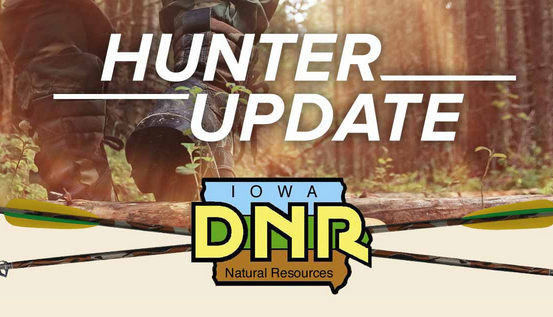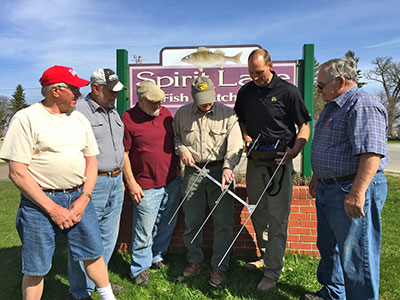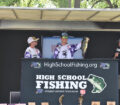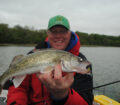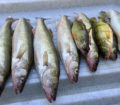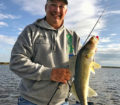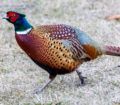By Steve Weisman
Slowly and steadily, the netting crews have been making progress in their walleye seining efforts. According to Kim Hawkins, Natural Resources Biologist and the Spirit Lake Hatchery Manager, two sample crews went out on East Okoboji Sunday, April 3 and collected 114 walleyes (male and female combined). That number increased to 176 on the next night.
On Tuesday, a total of seven crews netted on both East Okoboji and Big Spirit with 131 walleyes brought to the hatchery from East Okoboji and 282 from Big Spirit. Things went down dramatically on East Okoboji after that, but last Saturday night when the crews could hit the east side of Big Spirit, they brought in 294 walleyes.
Largest walleye to this point is an 11 pounder from East Okoboji, while both lakes produced a 39-pound musky.
It’s been tough, however, as the crews have had to battle up and down (cool) weather conditions and strong gusty winds.
One of the prime areas to sein on Big Spirit is the east side from Stony Point down through Reeds Run, but that has been next to impossible because of the strong northwest winds.
The hatchery is now open 8 a.m. to 8 p.m. daily until the netting process concludes, either because there are no ripe walleyes being taken in the nets or until the 1000 quarts/123 million walleye eggs have been collected.
At least this week’s weather won’t include a night with a 19-degree low.
Fishing for walleye
Although Big Spirit, East Okoboji and West Okoboji are off limits until the first weekend in May, there are still some great early walleye lakes. Five Island, Storm Lake, Silver Lake (Lake Park) and Clear Lake are four of the top lakes. Of course, you can also head to Center Lake, Lost Island Lake and Tuttle Lake (Dolliver). Plus, we have the Little Sioux and Des Moines River.
With the lakes, anglers can choose either fishing from shore, wader fishing or fishing from a boat. However, this is the time of year where shore fishing and wader fishing are probably the most preferred. With the rivers and the normally high water levels, most everything is shore fishing around lowhead dams.
For all of these lakes, early morning and evening hours are both good. Remember that evening fishing might not really take off until after 9 p.m. on some nights. I do think evening is the most preferred, because it is after work hours and the temperatures have warmed during the day. That’s definitely beneficial on the hands! Plus, consider fishing the windy side of the lake (unless it is a gale) and target rocky shorelines and areas where the walleyes are moving to spawn.
Presentations
Most anglers will be using 1/16 and 1/8 ounce jigs tipped with a minnow or some type of Berkley Gulp! Twisters also work well. It usually takes a slow retrieve, but anglers will mix in subtle little twitches to try and find out what is working best. Another good option is a slip bobber with a plain hook and minnow combination. If you fish after dark, a lighted slip bobber can really be helpful. Also, on a lake like Storm Lake, if you have access to a private dock, that can also give you an advantage.
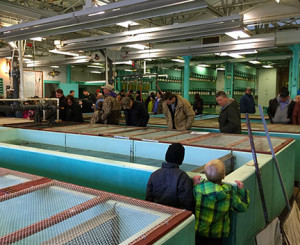
People kept coming to the hatchery all weekend just to see the big walleyes and muskies. (photo by Steve Weisman)
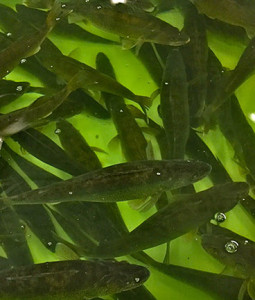
Although walleye collection has been somewhat slow because of the weather, the tanks still hold some beautiful walleyes taken from East Okoboji and Big Spirit Lake. (photo by Steve Weisman)
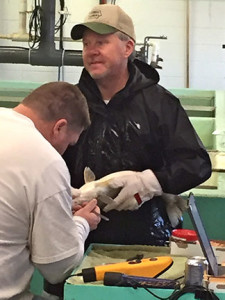
Hatchery personnel spent time replacing original tags with new tags that are designed to last longer than original ones and to allow for quicker data access. (photo by Steve Weisman)
[wwcAmzAffProducts asin=”B017NI1II4,B00XK5NNN8,B003V57NUQ,B005S6GY74,B00B722A3K,B00DN7CCIK,B00B722954,B00DN7BS4E,B00B7227U6,B00C0R4RLE,B00019NP16,B01A5IB5SW,B00DN7FQ8S,B004UVRYDG,B01H2D450S,B00XZNFX4W”][/wwcAmzAffProducts]

